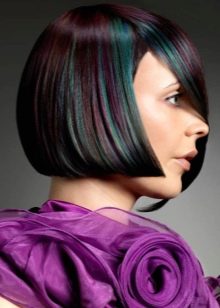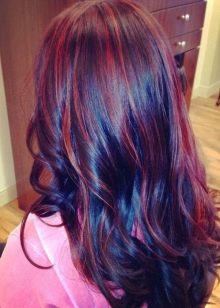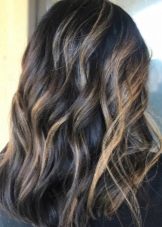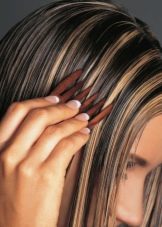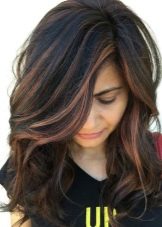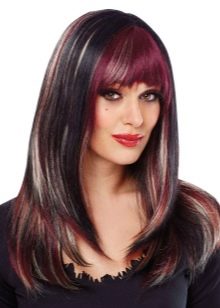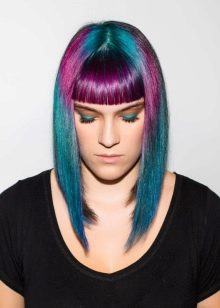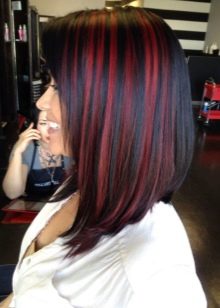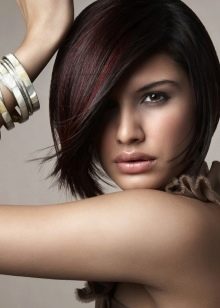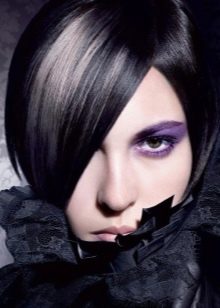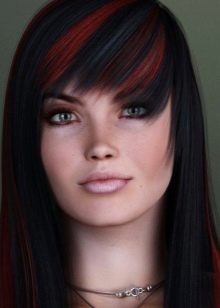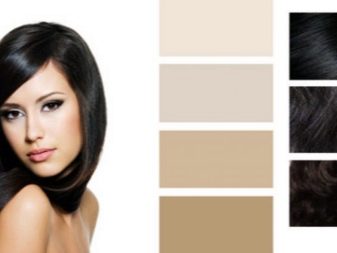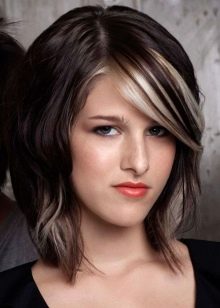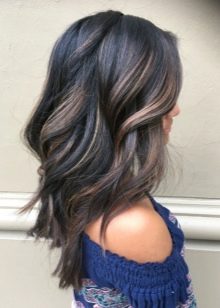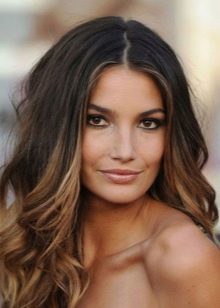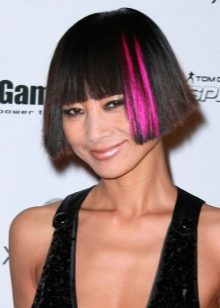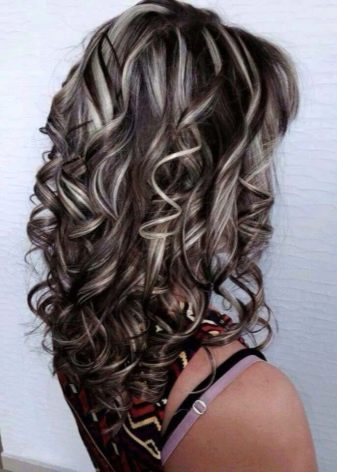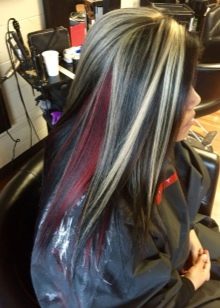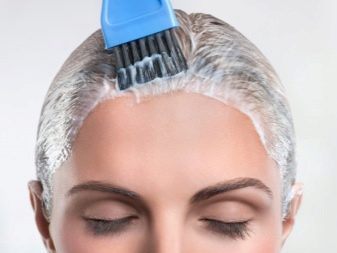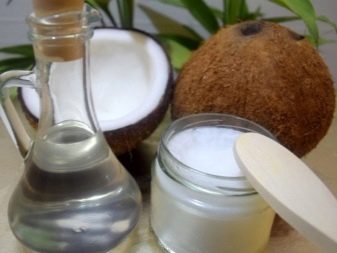Stylish heterogeneous staining with each season do not give up their positions, on the contrary, are becoming increasingly popular. Coloring on black hair looks particularly impressive and gives the image expressiveness. Such coloring looks great, regardless of the length of the strands, they can be long, short, medium length. Colors and shades are also incredibly diverse: dyed strands are made in white, red and other variants.
What is it like?
First of all, you need to figure out what is included in the concept of coloring. From the name it is clear that in such staining are used 2 or more shades. The maximum number of tones can reach several dozen, while they may be similar in color or contrast. The technique of coloring is different from highlighting by the fact that the strands are not lightened, namely they are colored, while partially selected strands are processed. All fashion technology type shatush, ombre also apply to coloring.
It is very important to choose the right shades so that the overall composition is harmonious.
Varieties
There are several types of coloring in the technique of coloring.
- Horizontally. It is also called transverse coloring, it is possible to use no more than 3 tones. In this technique, the strands are separated from each other into 3 parts horizontally: the roots, the middle and the bottom. Tones are selected as follows: as dark as possible at the roots, the middle and bottom are lighter.
Brunettes can safely leave the natural shade in the basal part. This option is economical because it does not require rapid re-dyeing and does not harm the roots.
- Vertical or longitudinal coloring. Here the possibility of applying shades is the widest, their number is practically unlimited. Strands are separated along and painted alternately. Transitions are uneven, may be contrasting, asymmetrical.
- By zones. Here a certain zone is selected, which is colored: bangs, ends, back of the head, temples.
- Patterned stencil. Performed using special tools, made in the form of a stencil, it is imposed on the strands and painted. Among the fashionable prints: animalistic, geometric. Short black strands are the perfect backdrop for this type of coloring.
Advantages and disadvantages
Coloring on dark strands has both a number of advantages and some disadvantages. Among the advantages can be identified:
- the opportunity to refresh the image;
- expressiveness of the composition;
- the right choice of colors and techniques will help rejuvenate and adjust the face;
- the curls seem bigger and thicker, healthier;
- variety of choice gives you all the possibilities for changing the image and experiments;
- spares hair roots;
- there is no need to adjust the staining often.
There are also disadvantages, they must be considered:
- black strands require aggressive clarification, which is not the best effect on the state of the tips;
- the procedure is expensive and requires a serious level of professionalism;
- most often requires daily installation, otherwise the effect disappears;
- the need to use special tools for dyed curls;
- Contrast coloring can not be painted over in monochrome, if you wanted;
- black hair has limitations in the choice of shades, not all are suitable for them;
- not suitable for curled hair, during the treatment of strands and changes in hormonal levels.
Choose a shade
Canonical is a technique in which dark strands are lightened in the face. Moreover, the use of different shades gives completely different results and effects: you can add or reset a dozen years, emphasize both the merits of the person and disadvantages. Therefore, it is important to choose the right palette of shades. The easiest way to rely on color type of face.
It is determined as follows: take two pieces of matter in warm-peach and cool-pink tones and attach to the chest. Compare which one makes you younger, more expressive, and which one muffles. From this proceed winter or autumn gamma closer to you The second method is the color of the veins on the elbow bend, if it has a green tint, you are closer to fall, blue and lilac speak of a winter color type.
Most often, black hair is characterized by a winter type, which gets along perfectly with cool scales: platinum, silver, pearls, steel. Black and brown strands are more characteristic of the autumn type, so it is better to choose warm shades: beige, gold, copper and honey, wheat, sand.
Strands of raven color are extremely difficult to brighten. To avoid the use of aggressive means, it is better to color the strands in close to natural tones: chestnut, chocolate, coffee, cinnamon and honey. Also interesting options with berry-wine palettes, eggplant. For a spectacular hairstyle is enough if the color differs by a couple of shades from the native.
If you like bold, extravagant details in the image, you can try Contrast coloration. However, this method has age restrictions, it is not suitable for mature, status ladies.
Transitions can be sharp or more blurry.
Among the contrasting shades it is best to stay on blue, red, violet. Red suitable for dark-skinned and visually add volume strands. Blue often picked to highlight bangs. Violet not suitable warm type, well combined with lilac. If your image allows for bold experiments, pay attention to the trendy pink gamut, which is very rich in cold and warm colors.
Black strands look incredibly good in dyeing horizontally, wide longitudinal strips visually make the hair longer. In this case, the transitions can be both gradient and clear. Among fashion trends You can select the following combinations:
- merlot, marsala and eggplant - both separately and in alternation with plum, chocolate, chestnut;
- short strands look great in contrasting bright colors;
- glare coloring, something between an ombre and highlighting, in which the ends remain the brightest.
Features for different lengths
Long strands give more options for coloring. At medium length The following options look spectacular:
- impression of burnt ends;
- the selection of the finest strands that differ from the native color by tone;
- bright gradient;
- natural staining, leaving the natural zone at the roots;
- straightening is lighter or darker than natural;
- wide gradient;
- blonding
Short haircuts most effective will be in such interpretations:
- Coloring by zones;
- highlighted bangs;
- multitonality;
- stencilled;
- contrast
If the strands are short, it is better to avoid a large number of bright shades, otherwise the effect may be reversed.
For average length, it is recommended to use about 7-8 shades.
Care after coloring
From what method of coloring is chosen, depends on the frequency of correction and methods of care. Since any staining negatively affects the condition of the strands, they need properly care:
- head washing should include the use of air conditioners;
- regularly make masks for painted strands;
- use coconut or argan oil;
- in the solarium and on the beach close the curls;
- try to avoid drying with a hair dryer and use styling devices less often;
- choose only products for dyed strands.
You will learn more about coloring black hair in the following video.

